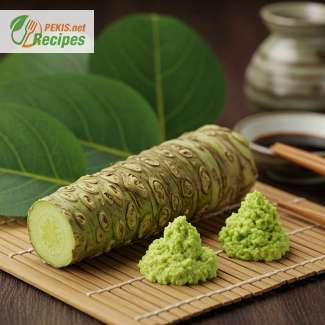
The Truth About Wasabi: Origins, Uses, and Health Benefits
Introduction
Wasabi is a well-known ingredient, particularly in Japanese cuisine, often recognized for its spicy, pungent kick that enhances sushi and sashimi. However, what many people may not realize is that real wasabi (Wasabia japonica) is quite rare and different from the common wasabi paste found in most restaurants.
Unlike the horseradish-based imitation, real wasabi is made from the rhizome of the Wasabia japonica plant, which grows naturally in Japan's cool, mountainous regions. The authentic version provides a complex, mildly sweet, and less abrasive heat, making it a prized ingredient among chefs and food enthusiasts. This article explores everything you need to know about wasabi—from its health benefits and culinary applications to its cultivation and secrets to proper usage.
What Are the Characteristics of Real Wasabi?
Real wasabi, known as "hon-wasabi", has distinct characteristics that set it apart from the widely available substitute:
- Appearance: Wasabi grows as a rhizome with broad, green leaves and produces a stem-like structure rather than a true root.
- Flavor Profile: It has a complex, fresh, and subtly sweet heat that is not as harsh as horseradish-based alternatives.
- Texture: When grated, wasabi forms a smooth paste with a slightly grainy consistency.
- Aroma: The real deal emits a mildly floral yet pungent aroma that dissipates quickly after grating.
- Short-lasting Heat: Unlike chili peppers, wasabi's spiciness fades quickly, making it an ideal condiment that does not overpower food.
What Are the Best Substitutes for Real Wasabi?
Since real wasabi is expensive and difficult to source, many people turn to alternatives. Some of the best substitutes include:
- Horseradish Paste: The most common replacement, often mixed with mustard and green food coloring.
- Dijon Mustard: Offers a tangy heat that can mimic wasabi in dips and sauces.
- Wasabi Powder: Made from a blend of horseradish, mustard, and cornstarch, this is a more affordable alternative.
- Spicy Mustard & Horseradish Mix: A homemade blend can create a similar sinus-clearing effect.
- Daikon Radish with Mustard: A milder option that mimics wasabi’s freshness.
Why Is Wasabi Used in Cuisine?
Wasabi is an integral part of Japanese culinary traditions, but its uses extend beyond just sushi. Here’s why it is widely appreciated:
- Enhances Flavor: The natural pungency of wasabi complements the delicate umami flavors of seafood.
- Neutralizes Fishy Smell: Wasabi helps to counteract strong seafood odors, making dishes more palatable.
- Aids Digestion: Its anti-microbial properties make it beneficial for digestion when consuming raw fish.
- Perfect for Meat & Vegetables: Beyond sushi, wasabi can be used in salads, marinades, and grilled meats.
- Adds a Unique Spicy Kick: Unlike chili peppers, wasabi’s heat doesn’t linger, making it a preferred choice for those who enjoy spice but dislike lingering burn.
Secrets to Using Wasabi Correctly
If you want to unlock the full potential of wasabi, consider these key secrets:
- Always Use Fresh Wasabi: Grate fresh wasabi right before serving to preserve its volatile compounds.
- Grate Properly: Use a sharkskin grater (oroshigane) for the best texture.
- Pair with the Right Foods: Wasabi works well with raw fish, meats, and even noodles.
- Do Not Mix into Soy Sauce: Instead of blending it into soy sauce, apply wasabi directly onto sushi to preserve its natural sharpness.
- Use Sparingly: A small amount is enough to enhance flavors without overpowering them.
Why Is Wasabi Perfect for Recipes?
Wasabi isn't just for sushi—it enhances a variety of dishes. Here’s why it works so well in recipes:
- Balances Sweet and Savory: Wasabi adds an intriguing contrast to sweet sauces and glazes.
- Brightens Flavors: The natural pungency brings out the best in meats and seafood.
- Complements Creamy Textures: Wasabi works beautifully in mayonnaise, dressings, and butter sauces.
- Boosts Aroma in Soups & Broths: Just a pinch of wasabi can enhance miso soup and noodle broths.
How Does Wasabi Work?
Wasabi's unique heat comes from isothiocyanates (ITCs), compounds that:
- Stimulate the sinuses rather than the tongue.
- Dissipate quickly, unlike chili peppers.
- Offer natural antibacterial properties, helping prevent foodborne illnesses.
Health Benefits of Wasabi
Beyond its culinary appeal, wasabi offers numerous health benefits:
- Antibacterial Properties: Helps fight foodborne pathogens.
- Anti-Inflammatory: Contains compounds that may reduce inflammation.
- Supports Heart Health: Lowers bad cholesterol levels.
- Improves Digestion: Aids in gut health by preventing bacterial infections.
- May Have Cancer-Fighting Properties: Some studies suggest ITCs could have anticancer effects.
Growing and Cultivating Wasabi
Growing wasabi is challenging due to its specific environmental needs:
- Requires cool temperatures (8-20°C) and high humidity.
- Prefers shade and natural water sources.
- Takes 1.5 to 3 years to reach maturity.
- Best grown in flowing, mineral-rich water, similar to mountain streams.
Wasabi is more than just a spicy sushi companion—it is a complex, versatile ingredient with numerous health benefits and unique culinary applications. Whether you are using it fresh or opting for substitutes, understanding wasabi’s true nature and best uses can elevate your cooking experience.
For those looking to experience the real taste of wasabi, sourcing fresh Wasabia japonica is worth the effort, bringing an authentic flavor that enhances any dish.
By following these insights, you can appreciate wasabi beyond just a condiment and integrate it into various recipes and applications for a richer culinary experience.